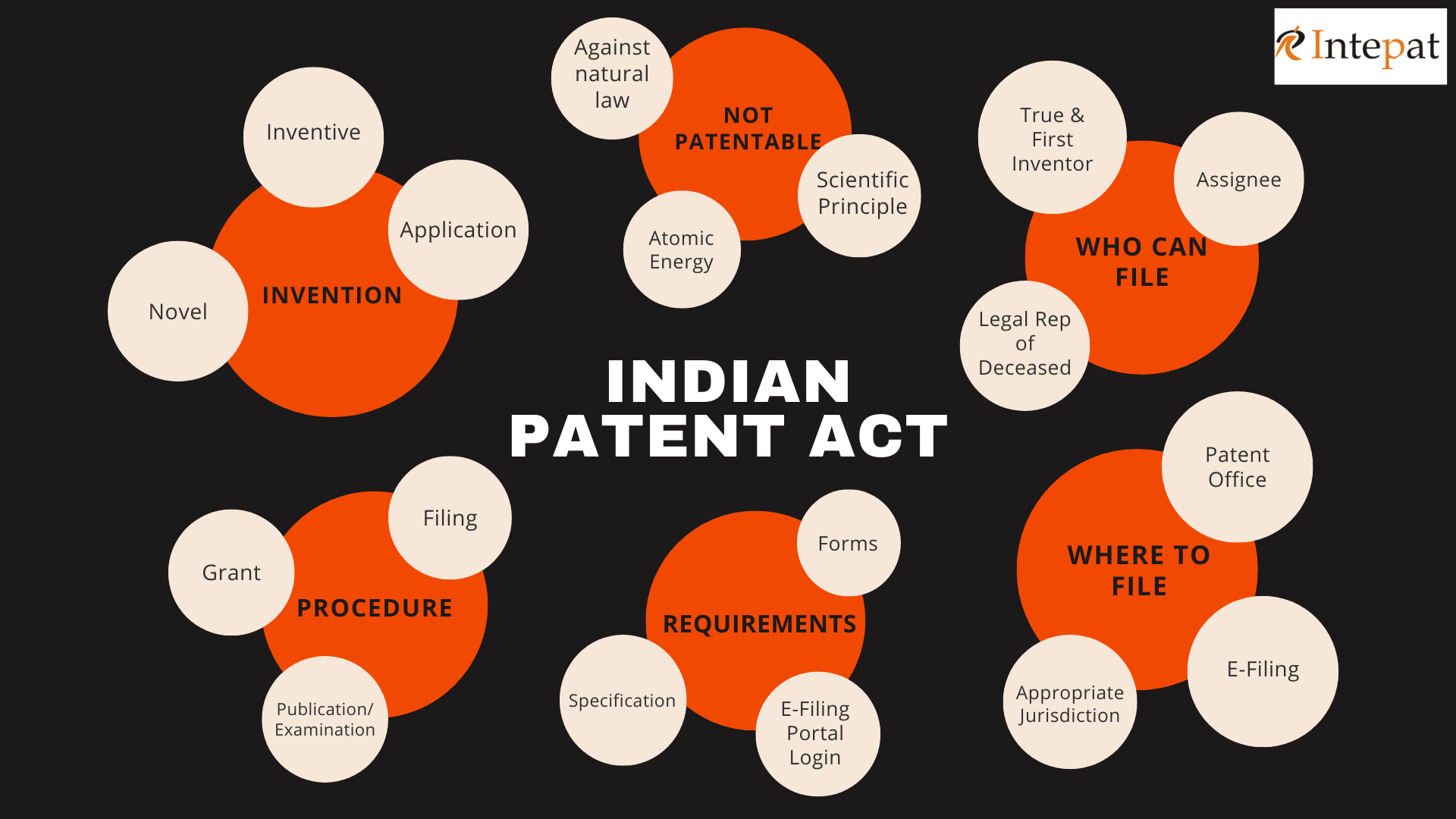The Indian Patents Act
The inventor of any invention always seeks patent protection for his invention. Patent protection protects their invention from unauthorized use and gives the creator a monopoly to exploit his invention and derive maximum benefit from it.
Patent protection is granted under the “Indian Patents Act,” and this protection subsists for 20 years. However, not all creations or inventions would warrant patent protection. The Indian Patent law lays down specific requisites for filing an Indian patent. To understand these requisites, it is essential to understand what amounts to an invention.
Inventions under the Indian Patents Act:
Now, S 2(j) of the Indian Patent Act 1970 defines an invention as follows:
‘invention means a new product or process involving an inventive step capable of industrial application.’
Simply put, any product or process will be deemed an invention if it is novel, non-obvious, involves an inventive step, and has industrial application. An invention should be novel; this means such an invention should not have existed.
Next, the invention should be non-obvious, implying that any person skilled in that field should not have anticipated the invention. Consider the invention of a chair with wheels. Any person skilled in the art of carpentry could have anticipated this. Therefore, such an invention would not be considered fit for protection under the Patent Act 1970, India.
Remarkably, there should exist an inventive step. This means that the invention should add to the existing body of technology and science. Lastly, it should have an industrial application, i.e., it should have some commercial value. Therefore, inventions that do not have any industrial application are termed, utility models. However, utility models are not protected in India.
Apart from this, the Patent Law in India also lists out particular inventions that do not qualify as an ‘invention’ under the Patents Act, i.e., will not qualify for Indian patent protection. The list is enumerated in Section 3 of the Act.
Not patentable inventions under the Patent Law in India:
1. First, a frivolous invention or an invention that claims something contrary to well-established natural laws. Example: If someone claims that he has invented a device that can completely nullify the earth’s gravitational force, it would be deemed a frivolous invention and hence not patentable.
2. Secondly, an invention whose use will prove contrary to public order or morality or cause severe damage to human, animal, or plant life. Ex: Any form of arms and ammunition, like guns, etc., are not patentable since its primary use is against public morality.
3. The mere discovery of a scientific principle or the formulation of an abstract theory would not amount to an invention.
4. The mere discovery of a new form of substance that does not enhance the known efficacy of the substance would not be termed an invention.
5. A substance obtained by a mere admixture is also not patentable. Example: Mixing any acid and base results in the formation of salt and water. Such salt will not be patentable.
6. The mere arrangement or rearrangement of devices, each functioning independently of one other in a known way, will not be an invention.
7. No invention concerning atomic energy is patentable, owing to the state’s national interest and security.
Who can file:
An application for a patent for an invention can be made by any of the following persons either jointly with any other person:
a) The true and first inventor of the invention.
b) The assignee of the true and first inventor.
c) The legal representative of the deceased true and first inventor or their assignee.
However, it is essential to note that ‘true and first inventor does not include either the first importer of an invention into India or a person to whom an invention is first communicated from outside India.
Where should we file:
There are four Patent Offices in India- Mumbai, Chennai, New Delhi, and Kolkata. The Kolkata office is the head office. Additionally, the territorial jurisdiction between the four offices is divided as follows:
Patent Office Branches:
| Patent Office Mumbai | Maharashtra, Gujarat, Madhya Pradesh, Goa, Daman & Diu, and Dadra & Nagar Haveli |
| Patent Office Chennai | Andhra Pradesh, Telangana, Kerala, Tamil Nadu, Karnataka, Puducherry, and Lakshadweep |
| Patent Office Delhi | Haryana, Himachal Pradesh, Jammu and Kashmir, Punjab, Rajasthan, Uttar Pradesh, Chandigarh, and Delhi |
| Patent Office Kolkatta (Head Office) | West Bengal, Bihar, Jharkhand, Uttarakhand, Odisha, Chhattisgarh, Assam, Meghalaya, Mizoram, Tripura, Arunachal Pradesh, Manipur, Nagaland, Sikkim, and Andaman & Nicobar Islands |
The appropriate office for filing the patent application can be identified by:
a) Place of residence, domicile, or business of the applicant.
b) Place where the invention originated.
c) Address for service in India given by the applicant. (This is applicable only in the case of foreign applications.)
Patent Filing Requirements
i) Application for grant of patent in Form 1.
ii) Proof of right to apply to the inventor. This is applicable if the invention has been assigned to someone else.
iii) Provisional or complete specification in Form 2 and drawings if any.
iv) Power of authority in Form 26 if filed through a patent agent. and
v) Finally, an application should bear the digital signature of the application or authorized person/ patent agent.
Patent Specification:
To obtain patent protection, an applicant must fully and particularly describe the invention for which the protection is claimed. It can be either provisional or complete. A complete specification is given when the invention is complete, i.e., ready to use. On the other hand, a provisional specification is provided when the invention has reached a stage wherein it can be disclosed on paper but has not attained the final step.
The disclosure of the invention in a complete specification must be such that a person skilled in the art may be able to perform the invention. This is possible only when an applicant discloses the invention fully and includes the best-performing method. However, this will not lead to the misappropriation of your invention. Any person who comes up with a similar invention after you have filed for a patent will be barred from doing so.
Patent Filing:
An online method (E-filing) for filing a patent in India.
The E-filing of a patent application requires adherence to the following procedure for filing a patent in India:
First, the applicant or agent should possess a digital signature.
Second, the applicant or agent should register as a new user and create a login ID on the Indian Patent Office Portal (https://ipindia.gov.in/)
Third, the Client Software on the portal should be downloaded and installed. It will generate an XML file wherein the soft copies of the documents can be uploaded.
On successful uploading, the application number and CBR receipt, along with the date and time of submission, are generated.
You may read about the E-Filing Patent Application in India to learn more about the E-filing process.
Patent Office Procedure
Once the Patent Office India receives your application, a date and a serial number are allotted. The application is digitized, verified, classified, and uploaded to the internal server of the office. Next is the screening of the application. The application is screened for any international patent classification. An examiner is allotted based on the technical field of an invention in the respective field. The application is also screened to see whether it is relevant to defense or atomic energy and whether the abstract requires correction or completion.
Next comes the scrutiny. The application is scrutinized for appropriate jurisdiction, proof of right to file, and whether all the relevant documents have been submitted. After 18 months of the date of filing or the priority date (whichever is earlier), the application for a patent is published in the official journal. This allows any third party to file a pre-grant opposition for the grant.
The Patent Office has indeed scrutinized the application and examined the invention to the best of its abilities. However, in order to be absolutely sure, a chance is given to the public to file an opposition under the grounds listed under S 25 (1) of the Patents Act. This opposition has to be filed after publication but before the grant of a patent.
In the event of the absence of opposition, the patent application proceeds further for examination and grant proceedings.
The examiner then examines the invention, and a report is prepared with objections, if any, and sent to the applicant. Based on the response from the applicant, and subsequent hearing, the Controller will pass the patent grant order based on merit.
With the grant of a patent, you get the exclusive right to prevent any third party from making, using, offering for sale, selling, or importing for such purposes that product in India.
Also, in the case of a process patent, you will get the exclusive right to prevent any third party from using, offering for sale, selling, or importing the product obtained directly by such a process in India for such purposes.
From the above, you must have learned what invention is, inventions that are not patentable, who and where to file, requirements, and procedures under the Indian Patent Act.
[cherry_button text=”Need Help? Connect with experts” url=”https://www.intepat.com/contact-us/” style=”success” centered=”yes” fluid_position=”right” icon_position=”top” bg_color=”#ea9525″ min_width=”33″ target=”_blank”]




